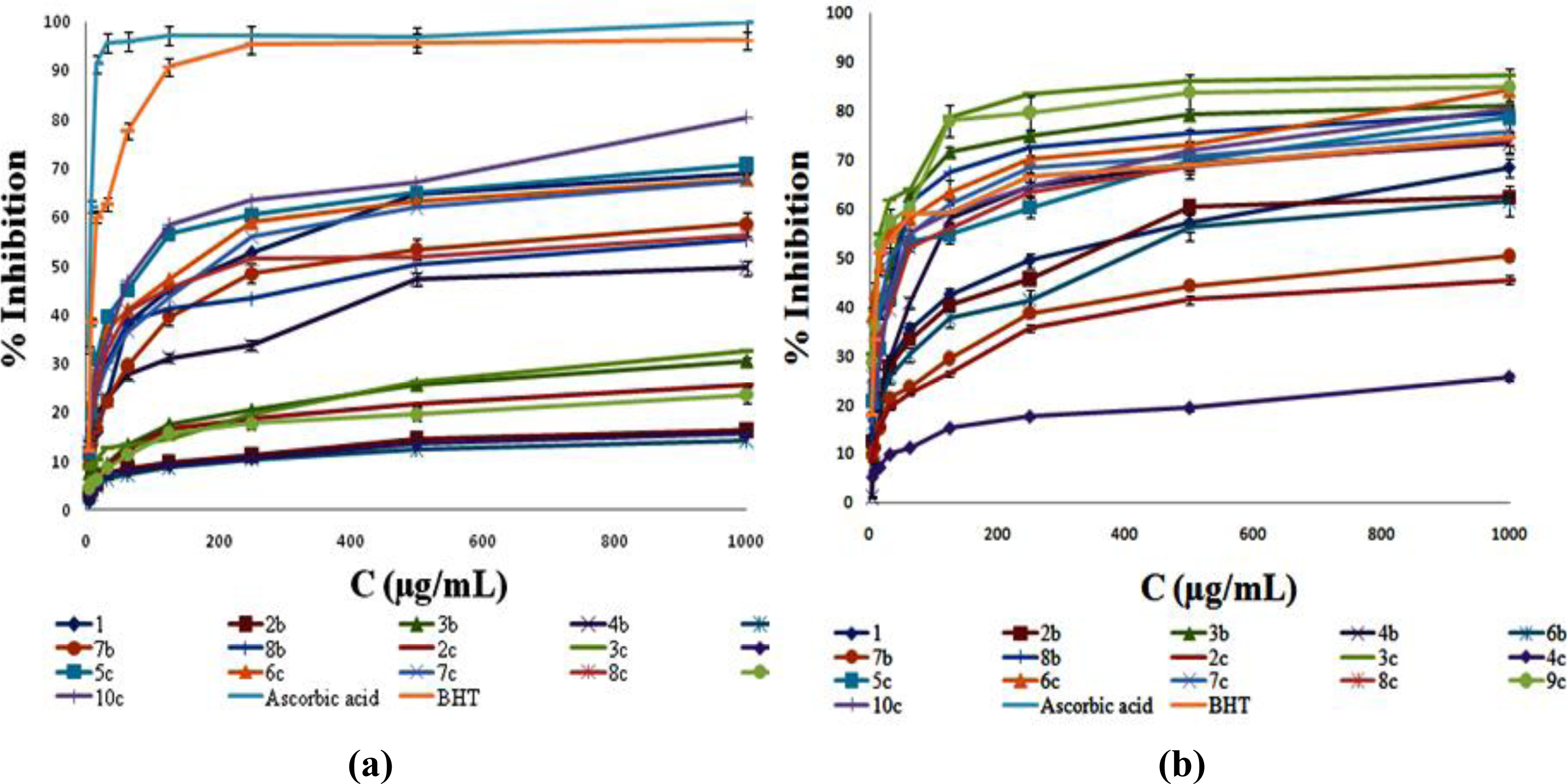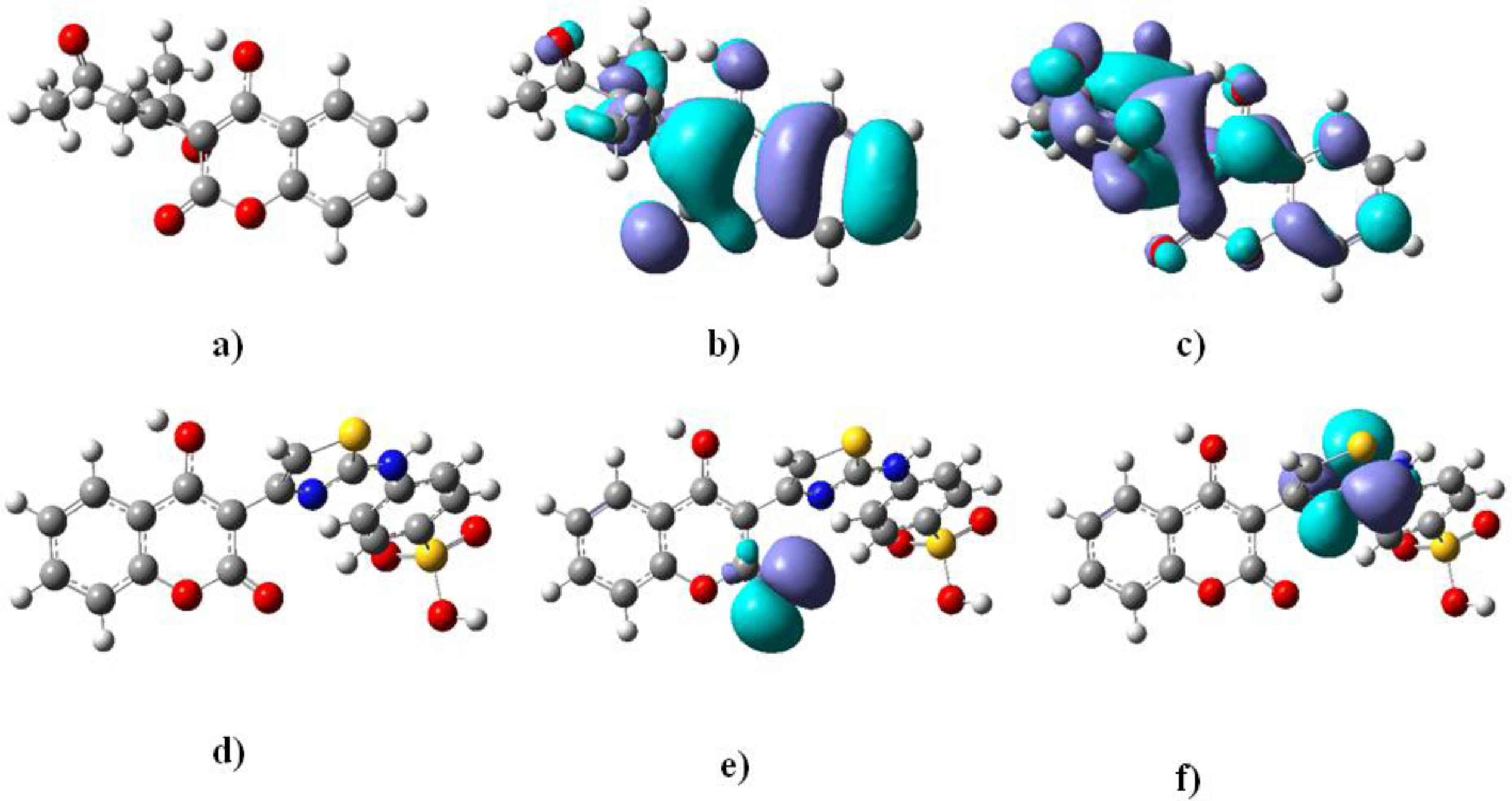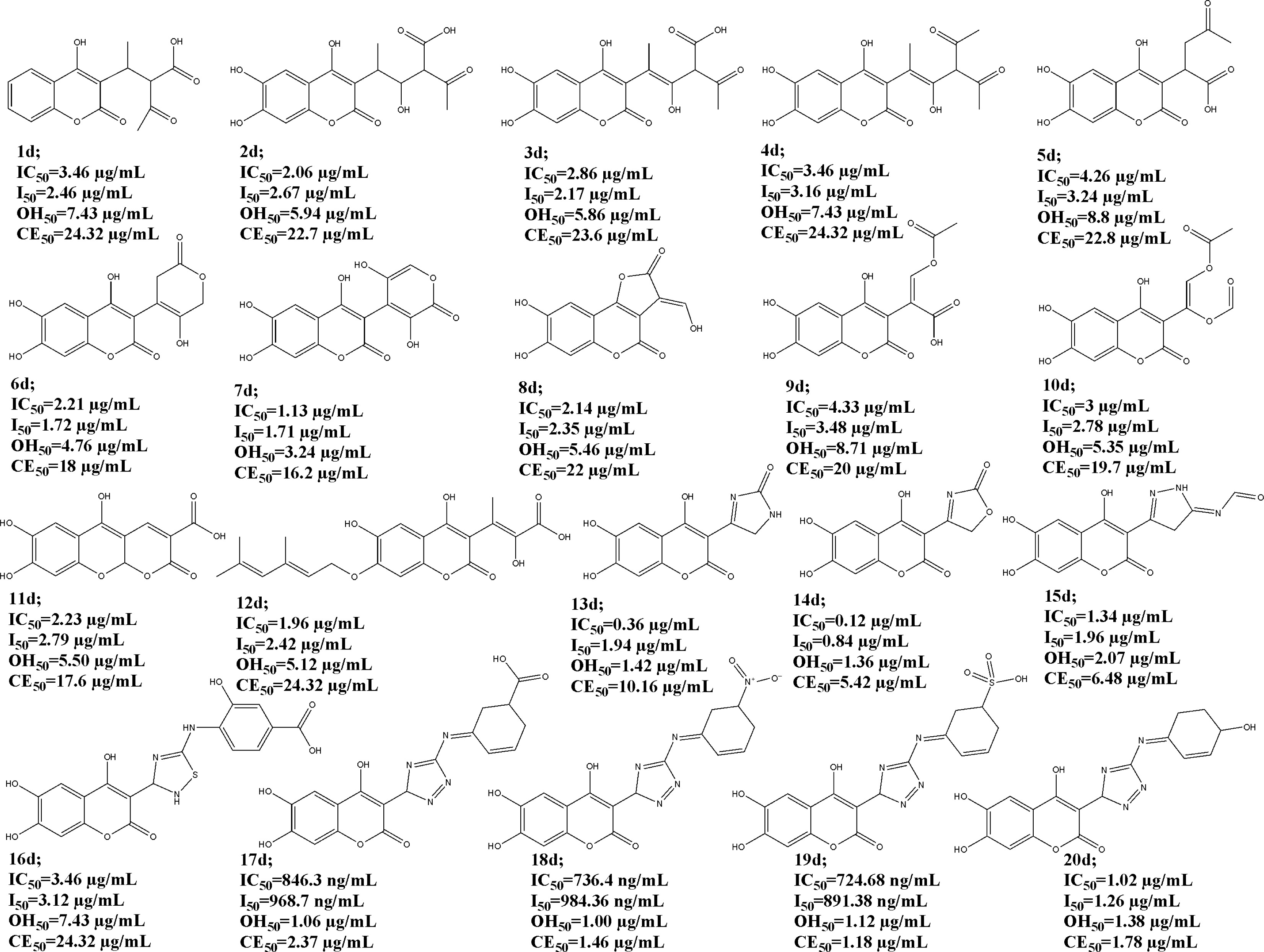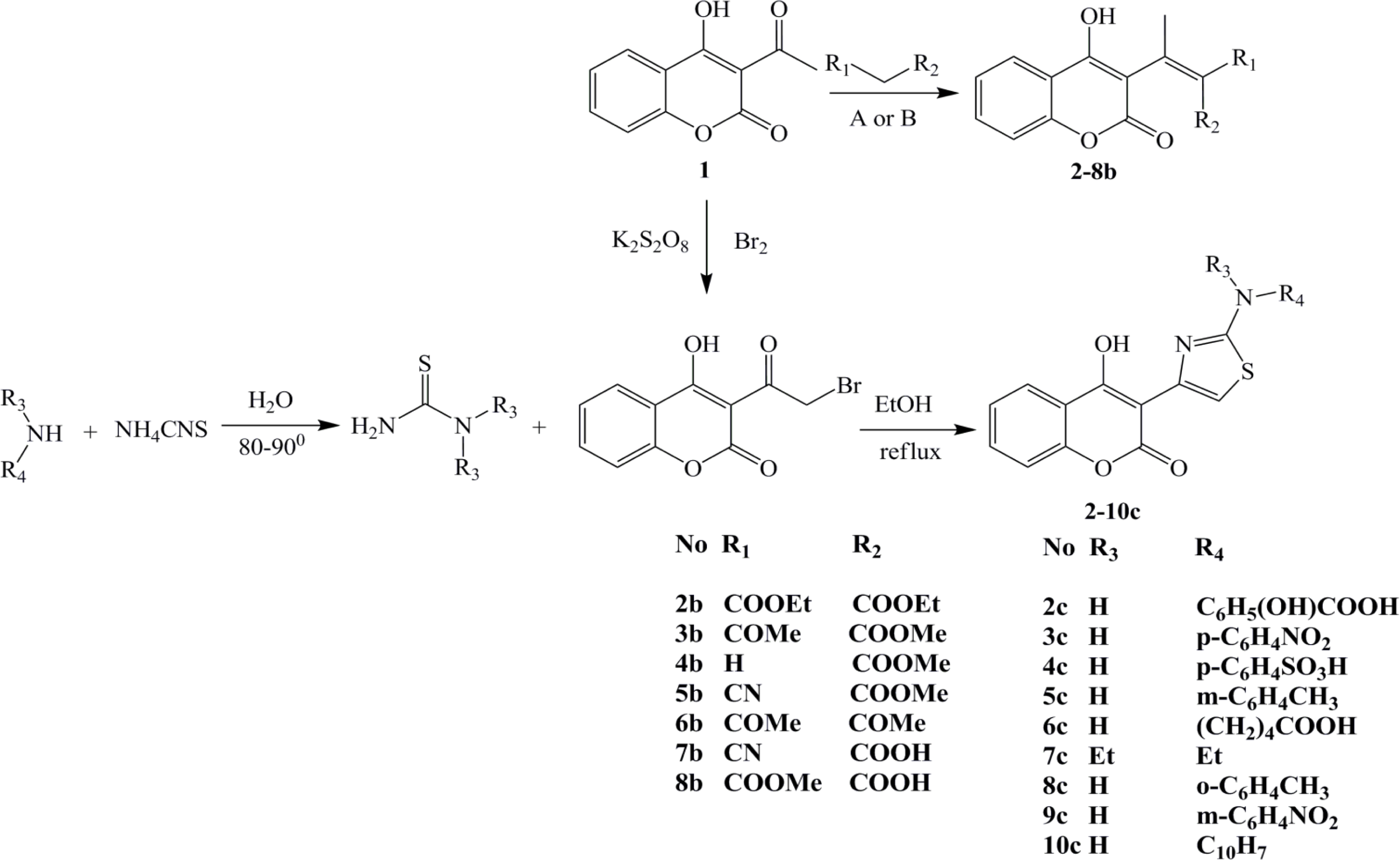In Vitro Antioxidant Activity of Selected 4-Hydroxy-chromene-2-one Derivatives—SAR, QSAR and DFT Studies
Abstract
:1. Introduction
2. Results and Discussion
2.1. Determination of Total Antioxidant Capacity
2.2. DPPH Radical Scavenging Activity
2.3. Inhibition of Lipid Peroxidation in Linoleic Acid Emulsion
2.4. Determination of Hydroxyl Radical Scavenging Activity
2.5. Measurement of Ferrous Ion Chelating Ability
2.6. QSAR Studies of the Antioxidant Activity
QSAR study on total antioxidant capacity
QSAR study on in vitro 60 min DPPH scavenging activity
QSAR study on inhibition of lipid peroxidation in linoleic acid emulsion (24 h):
QSAR study on in vitro hydroxyl radical scavenging activity
QSAR study on iron chelating ability
2.7. Structure-Based Design of Novel 4-Hydroxy Coumarin Antioxidants
3. Experimental Section
3.1. Chemistry
3.2. Chemicals
3.3. The Antioxidant Evaluation in Vitro
3.3.1. Determination of Total Antioxidant Capacity by Phosphomolibdenium Assay
3.3.2. DPPH Radical Scavenging Assay
3.3.3. Inhibition of Lipid Peroxidation in a Linoleic Acid Emulsion Assay
3.3.4. Hydroxyl Radical Scavenging Activity Assay
3.3.5. Ferrous Ion Chelating Ability Assay
3.4. Statistical Analysis
3.5. QSAR Study
3.5.1. Molecular Modeling
3.5.2. Molecular Descriptors
4. Conclusions
Abbreviations:
| NBO | Natural Bond Orbital; |
| OPLS | Optimized Potentials for Liquid Simulations; |
| AMMP | Another Molecular Mechanics Program; |
| PM6 | Parametric Method 6; |
| B3LYP | Becke, three-parameter, Lee-Yang-Parr. |
Acknowledgments
References
- Traykova, M; Kostova, I. Coumarin derivatives and antioxidative stress. Int. J. Pharmacol 2005, 1, 29–32. [Google Scholar]
- Droge, W. Free radicals in the physiological control of the cell function. Physiol. Rev 2002, 82, 47–95. [Google Scholar]
- Halliwell, B. How to characterize a biological antioxidant. Free Rad. Res 1990, 9, 1–32. [Google Scholar]
- Juliano, L; Colavita, AR; Leo, R; Pratico, D; Violi, F. Oxygen free radicals and platelet activation. Free Rad. Biol. Med 1997, 22, 999–1006. [Google Scholar]
- Lassegue, B; Griendling, KK. Reactive oxygen species in hypertension. Am. J. Hyper 2004, 17, 852–860. [Google Scholar]
- McIntosh, LJ; Trush, MA; Tronsoco, JC. Increased susceptibility of Alzheimer’s disease temporal cortex to oxygen-free radical-mediated processes. Free Rad. Biol. Med 1997, 23, 183–190. [Google Scholar]
- Festa, G; Aglitti, T; Duranti, G; Ricordi, R; Perticone, P; Cozzi, R. Strong antioxidant activity of ellagic acid in mammalian cells in vitro revealed by comet assay. Anticancer Res 2001, 21, 3903–3908. [Google Scholar]
- Hoult, J; Paya, M. Pharmacological and biochemical actions of simple coumarins: Natural products with therapeutic potential. Gen. Pharmacol 1996, 27, 713–722. [Google Scholar]
- Nićiforović, N; Mihailović, V; Mašković, P; Solujić, S; Stojković, A; Pavlović Muratspahić, D. Antioxidant activity of selected plant species; potential new sources. Food Chem. Toxicol 2010, 48, 3125–3130. [Google Scholar]
- Sinhg, R; Singh, B; Singh, S; Kumar, N; Kumar, N; Arora, S. Umbeliferone—An antioxidant isolated from Acacia nilotica (L.) Willd. Ex. Del. Food Chem 2010, 120, 825–830. [Google Scholar]
- Wu, C; Huang, M; Lin, Y; Ju, H; Ching, H. Antioxidant properties of Cortex Fraxini and its simple coumarins. Food Chem 2007, 104, 1464–1471. [Google Scholar]
- Ismail, M; Ibrar, M; Iqbal, Z; Hussain, J; Hussain, H; Ahmed, M; Ejaz, A; Choudhary, MI. Chemical constituents and antioxidant activity of Geranium wallichianum. Rec. Nat. Prod 2009, 3, 193–197. [Google Scholar]
- Thuong, PT; Hung, MT; Ngoc, TM; Ha do, T; Min, SB; Kwack, JS; Kang, ST; Choi, SJ; Bae, HK. Antioxidant activities of coumarins from Korean medicinal plants and their structure-activity relationships. Phytother. Res 2010, 24, 101–106. [Google Scholar]
- Ćavar, S; Kovač, F; Maksimović, M. Synthesis and antioxidant activity of selected 4-methylcoumarins. Food Chem 2009, 117, 135–142. [Google Scholar]
- Kontogiorgis, AC; Hadjipavlou-Litina, JD. Synthesis and biological evaluation of novel coumarin derivatives with a 7-azomethine linkage. Bioorg. Med. Chem. Lett 2004, 14, 611–614. [Google Scholar]
- Mladenović, M; Vuković, N; Nićiforović, N; Sukdolak, S; Solujić, S. Synthesis and molecular descriptor characterization of novel 4-hydroxy-chromene-2-one derivatives as antimicrobial agents. Molecules 2009, 14, 1495–1512. [Google Scholar]
- Vuković, N; Sukdolak, S; Solujić, S; Milošević, T. Synthesis and antimicrobial evaluation of some novel 2-aminothiazole derivatives of 4-hydroxy-chromene-2-one. Arch. der Pharm 2008, 341, 491–496. [Google Scholar]
- Pope, M; Swenberg, EC. Electronic Processes in Organic Crystals and Polymers, 2nd ed; Oxford Science Publications; Oxford University Press: New York, NY, USA, 1999; pp. 143–197. [Google Scholar]
- Vuković, N; Sukdolak, S; Solujić, S; Nićiforović, N. Substituted imino and amino derivatives of 4-hydroxycoumarins as novel antioxidant, antibacterial and antifungal agents: Synthesis and in vitro assessments. Food Chem 2010, 120, 1011–1018. [Google Scholar]
- Marković, SZ; Manojlović, TN. DFT study on the reactivity of OH groups in emodin: Structural and electronic features of emodin radicals. Monats. Chem 2009, 140, 1311–1318. [Google Scholar]
- Zhang, YH; Wang, FL. Theoretical elucidation of structure–activity relationship for coumarins to scavenge peroxyl radical. J. Mol. Struc. (TEOCHEM) 2004, 673, 199–202. [Google Scholar]
- Duh, PD; Tu, YY; Yen, GC. Antioxidant activity of aqueous extract of Harnjyur (Chrysanthemum morifolium Ramat). Lebensmwiss Technol 1999, 32, 269–277. [Google Scholar]
- Selassie, CD. History of quantitative structure-activity relationships. In Burger’s Medicinal Chemistry & Drug Discovery, 6th ed; Abraham, DJ, Ed.; John Wiley and Sons, Inc: New York, NY, USA, 2003; Volume 1; pp. 1–48. [Google Scholar]
- Liu, JK; Hu, L; Dong, ZJ; Hu, Q. DPPH radical scavenging activity of ten natural p-terphenyl derivatives obtained from three edible mushrooms indigenous to China. Chem. Biodiver 2004, 1, 601–605. [Google Scholar]
- Marx, JL. Oxygen free radicals linked to many diseases. Science 1985, 235, 529–531. [Google Scholar]
- Spessard, OG. ACD Labs/LogP dB 3.5 and ChemSketch 3.5. J. Chem. Inform. Comp. Sci 1998, 38, 1250–1253. [Google Scholar]
- Prieto, P; Pineda, M; Aguilar, M. Spectrophotometric quantification of antioxidant capacity trough the formation of a phosphomolybdenium complex: Specific application to the determination of vitamin E. Anal. Biochem 1999, 269, 337–341. [Google Scholar]
- Origin Pro 8. OriginLab Corporation, One Roundhouse Plaza: Northampton, MA, USA. 2009.
- Takao, T; Watanabe, N; Yagi, I; Sakata, K. A simple screening method for antioxidants and isolation of several antioxidants produced by marine bacteria from fish and shellfish. Biosci. Biotech. Biochem 1994, 58, 1780–1783. [Google Scholar]
- Masude, T; Isibe, D; Jitoe, A; Naramati, N. Antioxidant curcuminoids from rhizomes of Curcuma zanthorrhiza. Phytochemistry 1992, 33, 3645–3647. [Google Scholar]
- Halliwell, B; Gutteridge, JMC; Aruoma, O. The deoxyribose method: A simple “test-tube” assay for determination of rate constants for reactions of hydroxyl radicals. Anal. Biochem 1987, 165, 215–219. [Google Scholar]
- Carter, P. Spectrophotometric determination of serum iron at the submicrogram level with a new reagent (ferrozine). Anal. Biochem 1971, 40, 450–458. [Google Scholar]
- Software Spartan for Windows, Wavefunction, Inc.: Irvine, CA, USA, 2006.
- Pedretti, A; Villa, A; Vistoli, G. VEGA: A versatile program to convert, handle and visualize molecular structure on Windows-based PCs. J. Mol. Graph. Model 2002, 21, 47–49. [Google Scholar]
- MOPAC 2009. Stewart Computational Chemistry: Colorado Springs, CO, USA, 2009. Available online: http://www.openMOPAC.net (accessed on 13 April 2011).
- Frisch, MJ; Trucks, GW; Schlegel, HB; Scuseria, GE; Robb, MA; Cheeseman, JR; Montgomery, JA, Jr; Vreven, T; Kudin, KN; Burant, JC; Millam, JM; Iyengar, SS; Tomasi, J; Barone, V; Mennucci, B; Cossi, M; Scalmani, G; Rega, N; Petersson, GA; Nakatsuji, H; Hada, M; Ehara, M; Toyota, K; Fukuda, R; Hasegawa, J; Ishida, M; Nakajima, T; Honda, Y; Kitao, O; Nakai, H; Klene, M; Li, X; Knox, JE; Hratchian, HP; Cross, JB; Bakken, V; Adamo, C; Jaramillo, J; Gomperts, R; Stratmann, RE; Yazyev, O; Austin, AJ; Cammi, R; Pomelli, C; Ochterski, JW; Ayala, PY; Morokuma, K; Voth, GA; Salvador, P; Dannenberg, JJ; Zakrzewski, VG; Dapprich, S; Daniels, AD; Strain, MC; Farkas, O; Malick, DK; Rabuck, AD; Raghavachari, K; Foresman, JB; Ortiz, JV; Cui, Q; Baboul, AG; Clifford, S; Cioslowski, J; Stefanov, BB; Liu, G; Liashenko, A; Piskorz, P; Komaromi, I; Martin, RL; Fox, DJ; Keith, T; Al-Laham, MA; Peng, CY; Nanayakkara, A; Challacombe, M; Gill, PMW; Johnson, B; Chen, W; Wong, MW; Gonzalez, C; Pople, JA. Gaussian 03; Revision C02; Gaussian, Inc: Wallingford, CT, USA, 2003. [Google Scholar]





| Comp. | aTAC (μg/mL) | bTAC50 (μg/mL) | cIC50 (μg/mL) | |
|---|---|---|---|---|
| 30 min | 60 min | |||
| 1 | 121.46 ± 0.28b | 97.45 ± 0.31d | 133.70 ± 0.24 | 87.47 ± 0.24 |
| 2b | 278.24 ± 0.36 | 47.65 ± 0.24 | 6.2 ± 0.11 | 4.6 ± 0.26 |
| 3b | 54.08 ± 0.76 | 197.62 ± 0.21 | 44.93 ± 0.16 | 8.80 ± 0.14 |
| 4b | 138.32 ± 0.87 | 84.57 ± 0.65 | 41.64 ± 0.14 | 9.93 ± 0.22 |
| 6b | 212.12 ± 0.26 | 50.59 ± 0.12 | 5.14 ± 0.06 | 2.45 ± 0.17 |
| 7b | 324.01 ± 0.28 | 35.69 ± 0.17 | 246.63 ± 0.31 | 135.01 ± 0.31 |
| 8b | 106.64 ± 0.15 | 99.71 ± 0.28 | 37.76 ± 0.21 | 11.28 ± 0.19 |
| 2c | 514.24 ± 0.64 | 33.35 ± 0.24 | 4.94 ± 0.08 | 6.97 ± 0.25 |
| 3c | 86.14 ± 0.95 | 132.66 ± 0.16 | 29.07 ± 0.04 | 9.22 ± 0.17 |
| 4c | 742.67 ± 0.28 | 17.25 ± 0.15 | 4.72 ± 0.03 | 3.54 ± 0.32 |
| 5c | 198.84 ±0.24 | 53.16 ± 0.09 | 68.56 ± 0.07 | 66.54 ± 0.26 |
| 6c | 164.61 ± 0.32 | 72.35 ± 0.15 | 115.42 ± 0.15 | 94.30 ± 0.24 |
| 7c | 224.26 ± 0.31 | 46.67 ± 0.11 | 161.73 ± 0.46 | 93.58 ± 0.17 |
| 8c | 219.94 ± 0.56 | 47.18 ± 0.28 | 140.48 ± 0.26 | 60.31 ± 0.06 |
| 9c | 82.22 ± 0.96 | 136.94 ± 0.53 | 13.72 ± 0.25 | 4.79 ± 0.03 |
| 10c | 26.76 ± 0.48 | 219.43 ± 0.89 | 78.25 ± 0.11 | 76.41 ± 0.05 |
| Asc | / | / | 24.17 ± 0.07 | 15.61 ± 0.04 |
| BHT | / | / | 8.62 ± 0.02 | 6.05 ± 0.01 |
| Comp. | aI50 (μg/mL) | bOH50 (μg/mL) | cCE50 (μg/mL) | ||
|---|---|---|---|---|---|
| 24 h | 48 h | 72 h | |||
| 1 | 26.31 ± 0.31 | 55.23 ± 0.22 | 55.23 ± 0.32 | 17.77 ± 0.15 | 475.24 ± 0.21 |
| 2b | 7.77 ± 0.12 | 16.85 ± 0.15 | 13.01 ± 0.14 | 17.19 ± 0.06 | 45.0 ± 0.54 |
| 3b | 12.08 ± 0.12 | 28.07 ± 0.41 | 10.46 ± 0.28 | 32.21 ± 0.41 | 57.35 ± 0.34 |
| 4b | 18.96 ± 0.04 | 37.89 ± 0.28 | 80.95 ± 0.24 | 84.04 ± 0.02 | 62.5 ± 0.11 |
| 6b | <3.901 | 10.13 ± 0.16 | 10.76 ± 0.16 | 14.32 ± 0.15 | 28.64 ± 0.28 |
| 7b | 76.17 ± 0.25 | 216.85 ± 0.22 | 167.66 ± 0.46 | 9.89 ± 0.03 | 60.74 ± 0.41 |
| 8b | 11.49 ± 0.24 | 18.07 ± 0.31 | 16.02 ± 0.24 | 37.82 ± 0.08 | 55.18 ± 0.13 |
| 2c | 6.72 ± 0.37 | 17.89 ± 0.34 | 7.07 ± 0.34 | 9.81 ± 0.03 | 34.64 ± 0.11 |
| 3c | 24.94 ± 0.34 | 12.02 ± 0.09 | 51.53 ± 0.13 | 19.83 ± 0.24 | 5.5 ± 0.08 |
| 4c | <3.901 | 26.31 ± 0.16 | 10.09 ± 0.27 | 5.94 ± 0.04 | 43.19 ± 0.02 |
| 5c | 24.49 ± 0.37 | 100.94 ± 0.17 | 51.33 ± 0.27 | 70.51 ± 0.63 | 52.04 ± 0.45 |
| 6c | 33.46 ± 0.48 | 28.66 ± 0.17 | 83.29 ± 0.19 | 30.32 ± 0.34 | 62.25 ± 0.27 |
| 7c | 53.13 ± 0.19 | 40.28 ± 0.36 | 119.34 ± 0.24 | 36.88 ± 0.72 | 54.77 ± 0.16 |
| 8c | 33.01 ± 0.16 | 731.60 ± 0.28 | 80.98 ± 0.31 | 69.76 ±0.28 | 52.81 ± 0.25 |
| 9c | 5.88 ± 0.34 | 10.06 ± 0.34 | 12.23 ± 0.17 | 24.32 ± 0.11 | 7.76 ± 0.05 |
| 10c | 28.20 ± 0.26 | 62.34 ± 0.19 | 57.06 ± 0.29 | 54.82 ± 0.03 | 51.64 ± 0.26 |
| Asc | 246.14 ± 0.3 | 514.36 ± 0.16 | >1000 | 160.55 ± 0.19 | 76.31 ± 0.25 |
| BHT | <7.81 | <7.81 | <7.81 | 33.92 ± 0.34 | 85.48 ± 0.17 |
| Comp. | E1 | D1 | D2 | D3 | D4 | D5 | D6 | D7 | D8 | D9 |
|---|---|---|---|---|---|---|---|---|---|---|
| 1 | 114.32 | −9.99 | −1.49 | −8.50 | 0.99 | −0.62 | 0 | 0 | 124.41 | −0.529 |
| 2b | 199.74 | −10.01 | −1.56 | −8.45 | 0.99 | −0.66 | 0 | 0 | 203.33 | −1.561 |
| 3b | 227.25 | −9.96 | −1.54 | −8.42 | 1.04 | −0.63 | 0 | 0 | 165.18 | −1.318 |
| 4b | 224.96 | −9.98 | −1.45 | −8.53 | 1.02 | −0.61 | 0 | 0 | 192.32 | −0.035 |
| 6b | 205.84 | −10.04 | −1.65 | −8.39 | 1.03 | −0.67 | 0 | 0 | 171.66 | −1.679 |
| 7b | 211.94 | −10.04 | −1.69 | −8.35 | 1.06 | −0.69 | 0 | 0 | 173.41 | −1.765 |
| 8b | 216.27 | −9.04 | −1.45 | −7.59 | 0.96 | −0.66 | 0 | 0 | 246.34 | −1.709 |
| 2c | 242.37 | −9.00 | −1.95 | −7.05 | 1.55 | −0.61 | −0.59 | 0.25 | 233.72 | 1.216 |
| 3c | 255.69 | −8.99 | −1.62 | −7.37 | 1.53 | −0.46 | −0.62 | 0.27 | 249.55 | 3.129 |
| 4c | 239.26 | −8.90 | −1.13 | −7.77 | 1.63 | −0.65 | −0.31 | 0.29 | 225.94 | 0.702 |
| 5c | 244.56 | −8.92 | −0.94 | −7.78 | 1.36 | −0.70 | −0.66 | 0.47 | 230.13 | 2.904 |
| 6c | 249.78 | −8.89 | −0.95 | −7.94 | 1.59 | −0.67 | −0.68 | 0.27 | 208.37 | 1.921 |
| 7c | 269.29 | −8.91 | −1.07 | −7.84 | 1.69 | −0.63 | −0.69 | 0.26 | 225.74 | 1.856 |
| 8c | 251.48 | −8.97 | −1.76 | −7.21 | 1.61 | −0.68 | −0.62 | 0.24 | 237.20 | 3.380 |
| 9c | 281.35 | −8.87 | −1.23 | −7.64 | 0.99 | −0.65 | −0.64 | 0.25 | 248.00 | 3.129 |
| 10c | 271.52 | −8.79 | −1.16 | −7.63 | 0.99 | −0.65 | −0.65 | 0.26 | 222.34 | 3.603 |
| Comp. | pTAC50 | pIC50 | pI50 | pOH50 | pCE50 | |||||
|---|---|---|---|---|---|---|---|---|---|---|
| Obser. | Calc. | Obser. | Calc. | Obser. | Calc. | Obser. | Calc. | Obser. | Calc. | |
| 1 | 4.01 | 3.89 | 4.06 | 4.26 | 4.57 | 4.78 | 4.71 | 4.80 | 3.32 | 3.42 |
| 2b | 4.32 | 4.71 | 5.34 | 5.43 | 5.12 | 5.18 | 4.76 | 4.72 | 4.34 | 4.37 |
| 3b | 3.70 | 3.69 | 5.06 | 5.11 | 4.92 | 5.14 | 4.49 | 4.62 | 4.24 | 4.36 |
| 4b | 4.07 | 4.88 | 5.00 | 5.09 | 4.72 | 4.82 | 4.06 | 4.13 | 4.20 | 4.44 |
| 6b | 4.29 | 4.28 | 5.61 | 5.65 | 5.41 | 5.41 | 4.84 | 5.02 | 4.54 | 4.44 |
| 7b | 4.45 | 4.76 | 3.87 | 3.75 | 4.12 | 4.18 | 5.00 | 5.13 | 4.22 | 4.52 |
| 8b | 4.00 | 3.89 | 4.95 | 4.96 | 4.94 | 5.08 | 4.42 | 4.47 | 4.26 | 4.36 |
| 2c | 4.47 | 4.91 | 5.16 | 5.25 | 5.17 | 5.48 | 5.00 | 5.23 | 4.46 | 4.52 |
| 3c | 3.88 | 3.92 | 5.03 | 5.13 | 4.60 | 4.92 | 4.70 | 4.86 | 5.26 | 5.31 |
| 4c | 4.76 | 5.01 | 5.45 | 5.69 | 5.41 | 5.61 | 5.23 | 5.55 | 4.36 | 4.26 |
| 5c | 4.27 | 4.14 | 4.12 | 4.06 | 4.66 | 4.63 | 4.15 | 4.26 | 3.28 | 3.34 |
| 6c | 4.14 | 4.08 | 4.63 | 4.80 | 4.47 | 4.73 | 4.52 | 4.72 | 4.21 | 4.21 |
| 7c | 4.33 | 4.36 | 4.22 | 4.42 | 4.27 | 4.38 | 4.43 | 4.44 | 4.26 | 4.26 |
| 8c | 4.32 | 4.445 | 5.32 | 5.68 | 4.48 | 4.56 | 4.16 | 4.22 | 4.28 | 4.45 |
| 9c | 3.86 | 3.15 | 4.12 | 4.12 | 5.23 | 5.53 | 4.61 | 4.71 | 5.11 | 5.34 |
| 10c | 3.66 | 3.49 | 4.06 | 4.26 | 4.55 | 4.72 | 4.12 | 4.32 | 4.29 | 4.26 |
| D1a | D2 | D3 | D4 | D5 | D6 | D7 | D8 | D9 | A1b | A2 | A3 | A4 | A5 | |
|---|---|---|---|---|---|---|---|---|---|---|---|---|---|---|
| D1 | 1.00 | |||||||||||||
| D2 | 0.48 | 1.00 | ||||||||||||
| D3 | 0.96 | 0.91 | 1.00 | |||||||||||
| D4 | 0.48 | 0.51 | 0.37 | 1.00 | ||||||||||
| D5 | 0.36 | 0.29 | 0.91 | 0.96 | 1.00 | |||||||||
| D6 | 0.23 | 0.79 | 0.61 | 0.29 | 0.51 | 1.00 | ||||||||
| D7 | 0.22 | 0.24 | 0.41 | 0.34 | 0.55 | 0.84 | 1.00 | |||||||
| D8 | 0.11 | 0.13 | 0.24 | 0.09 | 0.38 | 0.31 | 0.41 | 1.00 | ||||||
| D9 | 0.26 | 0.42 | 0.35 | 0.14 | 0.18 | 0.31 | 0.29 | 0.19 | 1.00 | |||||
| A1 | 0.97 | 0.74 | 0.00 | 0.00 | 0.87 | 0.64 | 0.79 | 0.00 | 0.12 | 1.00 | ||||
| A2 | 0.00 | 0.00 | 0.00 | 0.98 | 0.00 | 0.78 | 0.98 | 0.00 | 0.26 | 0.00 | 1.00 | |||
| A3 | 0.64 | 0.00 | 0.00 | 0.93 | 0.00 | 0.00 | 0.68 | 0.00 | 0.94 | 0.00 | 0.68 | 1.00 | ||
| A4 | 0.76 | 0.95 | 0.00 | 0.00 | 0.98 | 0.00 | 0.00 | 0.00 | 0.09 | 0.00 | 0.34 | 0.17 | 1.00 | |
| A5 | 0.00 | 0.00 | 0.00 | 0.00 | 0.00 | 0.91 | 0.00 | 0.98 | 0.14 | 0.00 | 0.00 | 0.00 | 0.00 | 1.00 |
© 2011 by the authors; licensee MDPI, Basel, Switzerland. This article is an open-access article distributed under the terms and conditions of the Creative Commons Attribution license (http://creativecommons.org/licenses/by/3.0/).
Share and Cite
Mladenović, M.; Mihailović, M.; Bogojević, D.; Matić, S.; Nićiforović, N.; Mihailović, V.; Vuković, N.; Sukdolak, S.; Solujić, S. In Vitro Antioxidant Activity of Selected 4-Hydroxy-chromene-2-one Derivatives—SAR, QSAR and DFT Studies. Int. J. Mol. Sci. 2011, 12, 2822-2841. https://doi.org/10.3390/ijms12052822
Mladenović M, Mihailović M, Bogojević D, Matić S, Nićiforović N, Mihailović V, Vuković N, Sukdolak S, Solujić S. In Vitro Antioxidant Activity of Selected 4-Hydroxy-chromene-2-one Derivatives—SAR, QSAR and DFT Studies. International Journal of Molecular Sciences. 2011; 12(5):2822-2841. https://doi.org/10.3390/ijms12052822
Chicago/Turabian StyleMladenović, Milan, Mirjana Mihailović, Desanka Bogojević, Sanja Matić, Neda Nićiforović, Vladimir Mihailović, Nenad Vuković, Slobodan Sukdolak, and Slavica Solujić. 2011. "In Vitro Antioxidant Activity of Selected 4-Hydroxy-chromene-2-one Derivatives—SAR, QSAR and DFT Studies" International Journal of Molecular Sciences 12, no. 5: 2822-2841. https://doi.org/10.3390/ijms12052822




